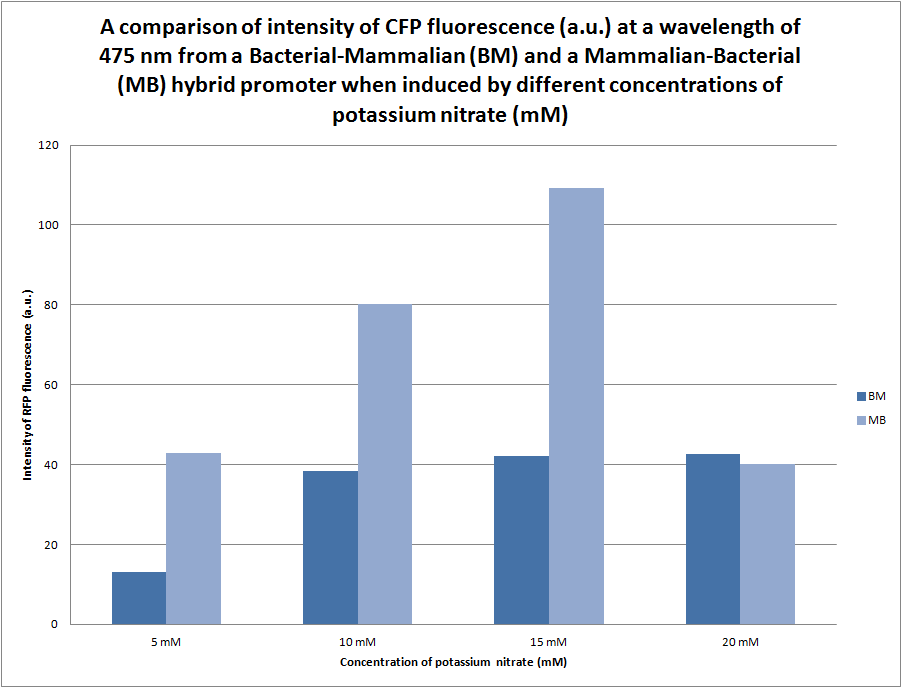Difference between revisions of "Part:BBa K774004"
| Line 7: | Line 7: | ||
[[Image:BM-CFP_Graph.png]] | [[Image:BM-CFP_Graph.png]] | ||
<br><br>The graph above shows the flourescence measured from the expression of eCFP due to the response of the bacterial-mammalian promoter to different concentrations of potassium nitrate. The wavelength reading which corresponds to eCFP is between 440-500nm. The graph clearly demonstrates that between 0mN and 15mM there is a proportional relationship between fluorescence intensity and potassium nitrate concentration. There appears to be a sharp increase in fluorescence intensity between 5mM and 10mM, and the rate at which intensity increase gradually decreases so that there is only a small increase between 15mM and 20mM. | <br><br>The graph above shows the flourescence measured from the expression of eCFP due to the response of the bacterial-mammalian promoter to different concentrations of potassium nitrate. The wavelength reading which corresponds to eCFP is between 440-500nm. The graph clearly demonstrates that between 0mN and 15mM there is a proportional relationship between fluorescence intensity and potassium nitrate concentration. There appears to be a sharp increase in fluorescence intensity between 5mM and 10mM, and the rate at which intensity increase gradually decreases so that there is only a small increase between 15mM and 20mM. | ||
| + | |||
| + | <br><br> | ||
| + | |||
| + | [[Image:CFP_Comparison_Graph.png]] | ||
| + | <br><br> | ||
| + | We were initially unsure of the effect that the orientation of the bacterial (pYEAR) and the mammalian (CaRG) genes would have in gene expression, therefore we synthesised two hybrid promoters in the orientation bacterial-mammalian and mammalian-bacterial. The graph above compares the intensity of fluorescence of the two hybrid promoters (BBa_K774004 and BBa_K774006) ligated to eCFP. There is a distinct difference between the intensity of fluorescence produced by the bacterial-mammalian promoter and the mammalian-promoter which is something that we would like to look into further. It is particularly interesting that at an intensity of 109a.u. the mammalian-bacterial promoter returns to the same level of intensity as the apparent maxiumum of the bacterial-mammalian promoter at 40a.u. | ||
<!-- Add more about the biology of this part here | <!-- Add more about the biology of this part here | ||
===Usage and Biology=== | ===Usage and Biology=== | ||
Revision as of 12:50, 23 September 2012
Bacterial-Mammalian promoter with eCFP reporter: BBaK216005 + CArG promoter sequence + BBa_E0420
Our hybrid promoter hopes to add to the systems already in the registry by creating a hybrid promoter that combines the bacterial promoter PyeaR and the mammalian CArG element , both of which respond to exogenous nitrogenous species. Combining the two would allow a more modular NO sensor that can be used in mammalian and bacterial cells interchangeably. The hybrid promoter has been attached to the reporter: enhanced Cyan Fluorescence Protein (eCFP). The hybrid promoter has been characterised by observing expression of flourescent protein, and found to have increased transcription in response to increasing concentrations of potassium nitrate.

The graph above shows the flourescence measured from the expression of eCFP due to the response of the bacterial-mammalian promoter to different concentrations of potassium nitrate. The wavelength reading which corresponds to eCFP is between 440-500nm. The graph clearly demonstrates that between 0mN and 15mM there is a proportional relationship between fluorescence intensity and potassium nitrate concentration. There appears to be a sharp increase in fluorescence intensity between 5mM and 10mM, and the rate at which intensity increase gradually decreases so that there is only a small increase between 15mM and 20mM.

We were initially unsure of the effect that the orientation of the bacterial (pYEAR) and the mammalian (CaRG) genes would have in gene expression, therefore we synthesised two hybrid promoters in the orientation bacterial-mammalian and mammalian-bacterial. The graph above compares the intensity of fluorescence of the two hybrid promoters (BBa_K774004 and BBa_K774006) ligated to eCFP. There is a distinct difference between the intensity of fluorescence produced by the bacterial-mammalian promoter and the mammalian-promoter which is something that we would like to look into further. It is particularly interesting that at an intensity of 109a.u. the mammalian-bacterial promoter returns to the same level of intensity as the apparent maxiumum of the bacterial-mammalian promoter at 40a.u.
- 10COMPATIBLE WITH RFC[10]
- 12COMPATIBLE WITH RFC[12]
- 21INCOMPATIBLE WITH RFC[21]Illegal BamHI site found at 101
- 23COMPATIBLE WITH RFC[23]
- 25COMPATIBLE WITH RFC[25]
- 1000COMPATIBLE WITH RFC[1000]
